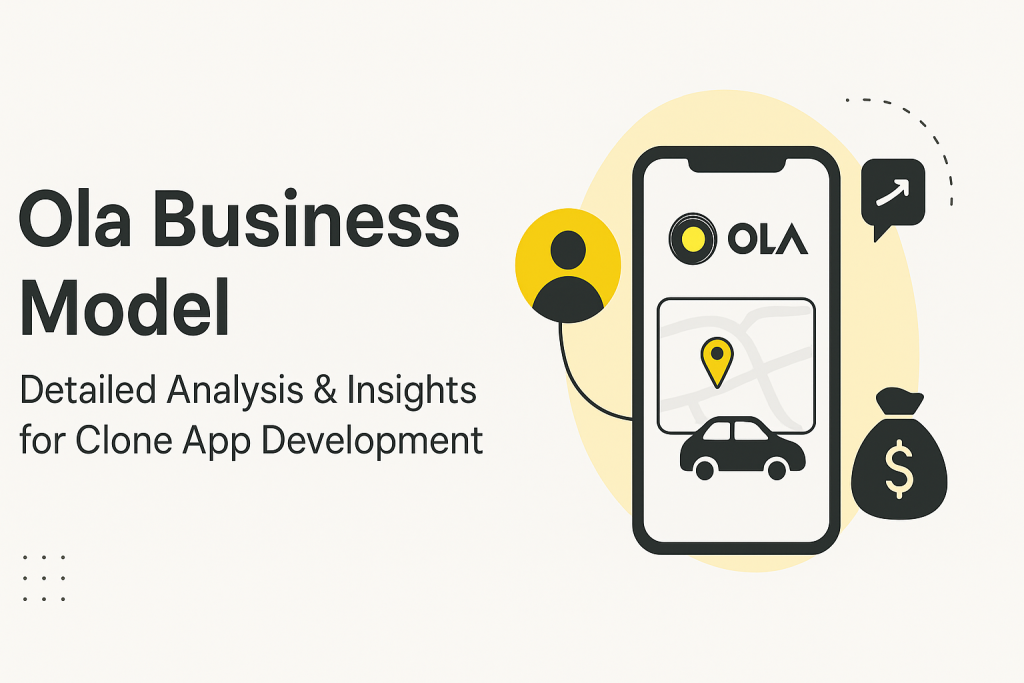
The on-demand transportation industry has revolutionized urban mobility, enabling millions to book rides with just a few taps on their smartphones. Ola—founded in India and now a global presence—has become one of the most successful examples of how to scale a ride-hailing platform. Its model offers invaluable lessons for entrepreneurs and mobile app developers aiming to create similar platforms.
This analysis breaks down Ola’s business strategy, operations, and value propositions, along with practical insights for developing a high-performing Ola-like clone app.
Ola’s Evolution from Local Start-up to International Player
Ola was founded in 2010 in Mumbai by Bhavish Aggarwal and Ankit Bhati. Initially, it was conceived as an intercity cab service. However, after identifying the immense potential in on-demand urban rides, Ola pivoted toward app-based ride booking.
By strategically expanding to over 250 cities in India and later entering markets like Australia, New Zealand, and the UK, Ola has positioned itself as Uber’s strongest competitor in India and a formidable player globally. Major investments from SoftBank, Hyundai, and Kia—totaling hundreds of millions of dollars—have fueled its rapid growth and diversification into areas like bike taxis, auto rickshaw bookings, and even electric mobility through Ola Electric. For entrepreneurs inspired by Ola’s journey, launching an uber clone taxi app can be a smart way to enter the competitive ride-hailing market with proven features and scalable technology.
The Core Business Model: An Aggregator Framework
Ola operates as an aggregator platform, connecting drivers and passengers without owning the vehicles. This capital-light approach allows scalability without the heavy asset burden of fleet ownership.
Key Stakeholders:
- Riders: Individuals seeking convenient, affordable, and safe transportation.
- Drivers/Vehicle Owners: Professionals or fleet operators offering rides for a commission.
- Corporate Clients: Businesses arranging travel for employees.
- Partners & Vendors: Automotive manufacturers, maintenance providers, payment gateways, and marketing agencies.
How Ola Works – Step-by-Step
- Booking Request: Riders enter their pickup and drop-off locations via the app.
- Matching Algorithm: Ola’s system assigns the nearest available driver.
- Real-time Tracking: Riders and drivers both have GPS-enabled route visibility.
- Payment Processing: Multiple payment methods including cash, cards, wallets, and UPI.
- Rating System: Both riders and drivers can rate each other, ensuring accountability.
Ola’s Key Operational Pillars
Platform Management: Maintaining a seamless, bug-free experience across Android, iOS, and web platforms.
Driver Onboarding: Rigorous verification, training, and app setup to ensure quality service.
Safety Protocols: Emergency contact buttons, ride tracking, SOS alerts, and driver background checks.
Customer Support: 24/7 assistance via chat, email, or phone to resolve queries quickly.
Data Analytics: Optimizing pricing, driver allocation, and route planning through data-driven decisions.
Value Propositions
For Riders
- Wide Service Range: Micro (affordable rides), Prime (premium), rentals, outstation trips, bike taxis, and autos.
- Ease of Booking: Fast ride-matching and clear fare estimates.
- Safety & Trust: SOS features, driver verification, and in-ride GPS tracking.
- Flexible Payment Options: Cash, cards, mobile wallets, and Ola Money.
For Drivers
- Flexible Earnings: Drive part-time or full-time with freedom to choose hours.
- Incentives: Bonuses for completing targets, high ratings, or peak-hour rides.
- Support Network: Driver helplines, training, and access to vehicle leasing programs.
Target Market Segments
- Urban Commuters – Individuals relying on daily app-based rides.
- Budget Travelers – Customers looking for low-cost mobility options like Ola Share.
- Corporate Clients – Bulk booking and regular transport arrangements.
- Intercity Travelers – Passengers booking outstation rides or rentals.
Revenue Streams
Ola’s earnings come from multiple channels:
- Commission from Drivers – A percentage per ride (usually 15–30%).
- Surge Pricing – Increased fares during high demand.
- Ola Select & Subscription Plans – Membership perks for riders.
- Leasing Programs – Earning from vehicle rentals to drivers.
- In-app Promotions – Partnered brands advertising on Ola’s platform.
Ola’s Growth Strategies
- Service Diversification – Adding food delivery (Ola Café, now discontinued), electric scooters, and corporate travel.
- Local Adaptation – Introducing auto-rickshaw booking in India and focusing on ride types relevant to each market.
- Technological Investments – AI-based driver allocation, predictive demand mapping, and app performance optimization.
- Sustainability Goals – Launching Ola Electric for a greener future.
Lessons for Clone App Development
For entrepreneurs or businesses aiming to replicate Ola’s success with a ride-hailing clone app, the following features and strategies are essential:
Dual-User Interface: Separate, dedicated apps for drivers and passengers with role-specific features.
Real-time GPS & Navigation: Accurate route mapping, ETA calculations, and live ride tracking.
Payment Flexibility: Integration of multiple payment gateways, digital wallets, and even cryptocurrency for future-readiness.
Safety Measures: Panic buttons, ride-sharing options, and AI-based anomaly detection for suspicious rides.
Scalable Architecture: Cloud-based infrastructure to handle increasing user load without performance lags.
Loyalty Programs & Offers: Coupons, referrals, and subscription plans to increase retention.
Analytics Dashboard: For admins to track revenue, ride metrics, and performance indicators.
Challenges & Considerations:
While Ola’s model is highly successful, clone app developers must be aware of:
- Regulatory Compliance: Adhering to transport laws in each market.
- Market Saturation: Competing with established players like Uber, Lyft, and regional apps.
- Driver Supply Balance: Ensuring enough active drivers during peak demand.
- Trust & Safety Concerns: Building strong security measures from day one.
Final Insights
Ola’s success lies in:
- Combining affordability and reliability.
- Constant service innovation.
- Maintaining local adaptability while scaling globally.
For businesses planning to create a similar app, the focus should be on:
- A smooth user experience.
- Driver-friendly policies.
- Continuous feature updates based on market feedback.
By integrating these strategies, a ride-hailing clone app can not only replicate Ola’s operational strengths but also carve out a niche in competitive markets. By leveraging Zybertaxi and tailoring it to include these proven elements while layering on your own innovations, you can make an uber clone app that launches as a compelling, agile alternative in the ride-hailing space—resonating with riders, drivers, and stakeholders alike.
